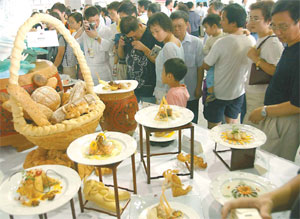Guangzhou locals get taste for adventure
By Steven Chen (China Daily)Updated: 2007-05-05 08:58
GUANGZHOU: Take an evening walk down the restaurant district in Huifu Donglu, near Guangzhou's famed shopping mecca Beijing Road, and one thing you'll notice immediately is the diversity of the fare on offer.
|
|
After years of eating their native Cantonese food, Guangzhou locals are flocking to Southeast Asian restaurants drawn by the promise of new and exciting flavors like chili, peppers and terasi (shrimp paste).
"Customers are tired of eating the same thing all the time and want something new," says Andy Somchai Cutjapun, a Thai native and head chef at Golden Dragon, which serves dozens of tables each night at its two- storey location.
The veteran chef attributes the growing popularity to his staying true to original Thai recipes rather than trying to cater too much to local tastes.
"Local Chinese cannot eat traditional Thai food, which is extremely hot, so we make it less spicy to suit their tastes. But at all times, the restaurant serves authentic Thai food using authentic ingredients."
The most popular dishes at the restaurant are charcoal grilled Japanese mackerel and chillied seafish, the chef says.
The same desire to stick to original recipes is at work at nearby Indonesian restaurant Pandan.
"We only serve food prepared using authentic recipes," manager So Siuwai says when explaining why his 70-seat restaurant serving delicacies like king garlic prawns and nasi goring (fried rice) is filled on a nightly basis.
"Japanese and foreign patrons seem to handle the spicy concoctions easily, locals prefer simpler, cleaner tastes," said CD, the restaurant's head chef.
Unusually, half of the eight cooking staff at Pandan are Indonesian housewives, most with children, rather than professional chefs, as the aim is to deliver the authentic homecooking experience desired by management.
Since "many customers do not know how to order Indonesian food", eating at Pandan is an education, So says.
So far, patrons have embraced such novel ideas as eating steamed rice with forks or even their hands, as they scoop up food from banana leaf placemats as is done in Indonesia.
Underpinning the desire to try new things is a strong economy creating greater disposable incomes, So says.
"Now people have more money, they can afford to eat out more often, and they want to try something new and exciting. Also, more people are traveling overseas to other countries in Asia. They will go to Thailand, or Vietnam or Indonesia, and try the food there and find they like it.
"When they come home, they look for the same kind of foods here," So says.
Nowhere testifies to this new-found spirit of culinary adventure than Tiger Prawn, a Vietnamese restaurant that is the busiest place on Huifu Donglu.
Every night the 200-seat restaurant is full and between 50 and 100 people queue up waiting for a table with mouths watering as the smell of pan-fried shrimp wafts out of the kitchen.
Many people think Vietnam's cuisine is simple, but according to Wayne Chan, an overseas Chinese from Australia who co-owns the restaurant with his Vietnamese wife and head chef and trainer, Eunie, this couldn't be further from the truth.
"Vietnamese food actually has a rich cultural past," he says.
As a former French colony, "Vietnam was exposed to many international influences and this influenced the development of our cuisine. Also, its proximity to other Southeast Asian countries means that our food has been infused with these other flavors and this makes it very unique".
"I think this is why our food is so popular with locals."
But perhaps Tiger Prawn's biggest draw is its affordable menu, as great effort is made to keep prices as low as possible.
"Where else in Guangzhou, can you get such tasty, authentic Vietnamese food at fast food prices?" he says.
|
||
|
||
|
|

